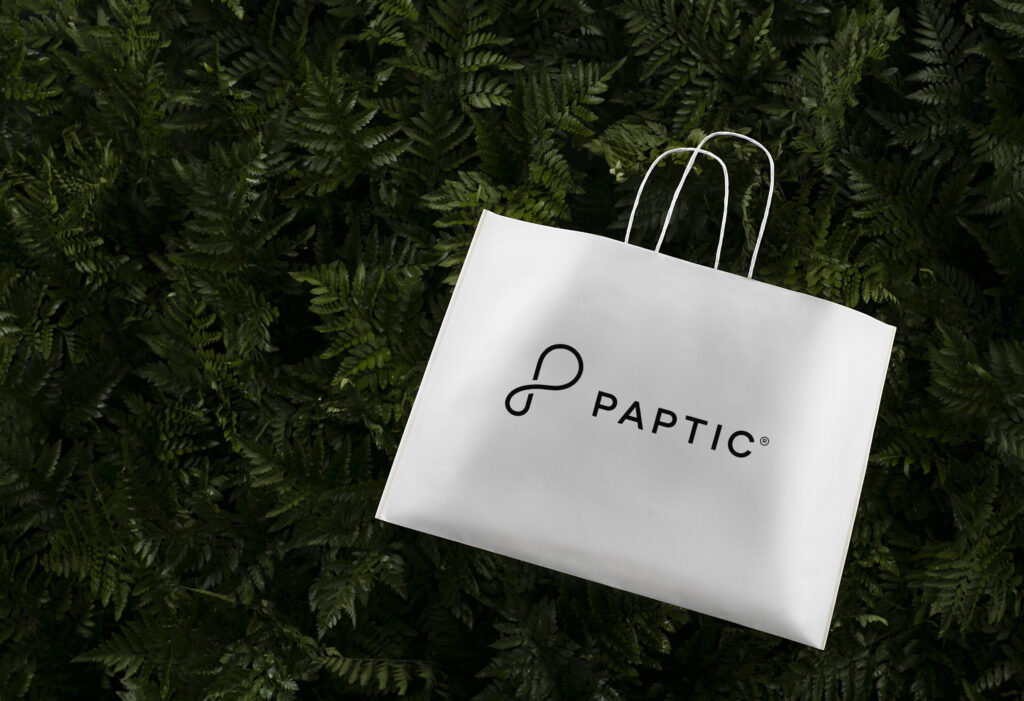Finnish innovation challenges plastic: New-generation paper bag fights against plastic waste in oceans

Millions of tonnes of plastic waste end up in the oceans every year. Environmental damage would be reduced if the fossil raw material of plastics was replaced with biodegradable material. Paptic, a startup company from Finland, has a promising recipe for manufacturing plastic bags from wood-based materials. Commercial production may start as early as next year.
Paptic has patented a technology that enables paper to challenge plastic in the packaging market. Paptic’s material, also called Paptic, is made of long-fibre wood pulp combining the best properties of both plastic and wood. It is durable and flexible and can be recycled and processed in many ways. The wood used as raw material comes from certified, sustainably managed coniferous forests.
The innovative idea was born because of the vast rafts of waste floating in the oceans and creating a serious threat to the environment. Simultaneously with the increasing news about marine garbage patches, the business world began to show more interest in bio-based materials.
With the European Parliament adopting a directive to reduce the use of plastic bags in the spring of 2015, the time was ripe to start Paptic. The development of a brand new material began.
“The main idea was to get the product on to the market as fast as possible because the window was open,” says Esa Torniainen, one of the three founders of Paptic.
“Only a while ago, it was enough for companies to talk about sustainability. Now, consumers want to see something actually done.”
Reusing decommissioned paper machines
Torniainen and his business partners Tuomas Mustonen and Karita Kinnunen-Raudaskoski have a lengthy experience in the paper industry. Paptic was born while the three founders were working at VTT Technical Research Centre of Finland. As the technology to manufacture Paptic, they selected foaming, which allows the new material to be produced on old paper machines.

“Paptic’s technology does not require a new billion-euro facility. Instead, we can give a new life to a decommissioned paper machine,” Torniainen says.
At the beginning of this year, when the company announced that it was looking for a partner and a paper machine, it received more inquiries than could be handled. Provided the company can also raise a total of ten million euros in funding, the first Paptic paper machine will be launched in late 2018.
Torniainen sees promising prospects for starting the operation. The Paptic product has attracted the interest of many international brands and retail chains.
In February, the Finnish business magazine Talouselämä chose Paptic as one of Finland’s top ten startup companies. In May, the Paptic material hit silver when the German Nova Institute named the biomaterials of the year 2017.
Image-driven
So far, Paptic operates a pilot plant in Espoo. Due to the small scale only test batches of bags have been supplied to customers, such as the Seppälä clothing stores last summer.
The Paptic carrier bag has a nice, soft feel to it. Its look and sturdiness resemble those of higher-end paper bags. According to Torniainen, the bag is indeed ideal for fashion and cosmetics chains.
“Paptic does not project an image of low cost. Rather, it reinforces the image of the brand packed in it. Best of all, it is recyclable not only physically but mentally,” Torniainen says, meaning that a trend-conscious consumer prefers being seen carrying a Paptic bag to toting a plain one.
Torniainen, responsible for the business development at Paptic, frequently uses the word “brand”. Materials such as Paptic have potential because of the willingness of many well-known brands to get rid of plastic. For example, Adidas has stopped using plastic bags and Lego has invested huge sums in the development of biomaterials.
To become world’s first brand in packaging
Paptic’s price is on a par with that of a high-quality paper bag. However, bags are just one possibility of using the Paptic material. The company plans to enter the markets of all pliable packagings, as the material is equally well suited to foodstuffs and online shops.
Paptic also wants to become a recognized brand in itself. Managing Director Tuomas Mustonen predicts that in the future, Paptic will be known as the Gore-Tex of packaging.
“Although our best known product now is a bag, in the future it should be a roll,” Torniainen says. In other words, instead of producing bags or packages, Paptic supplies the material for them.
When the Talouselämä jury of venture capitalists chose the hottest companies in 2017, Paptic gained points not only for its technology, but also for its compatibility with the existing production chain of plastic bags.
Torniainen points out that there must also be a need and a demand for every innovation. “Bioeconomy will only have value when the new bio-based products can replace some non-bio-based ones, that is, offer more durable solutions.”
4 kommenttia “Finnish innovation challenges plastic: New-generation paper bag fights against plastic waste in oceans” artikkeliin
Dear M/S,
I would like to have more information on your new innovation of Paptic. How we can market your production or products made by your organisation. in Asia and African market.
Best regards,
Mike Jabarin
+35845 1286880
Dear Mr. Jabarin, this is not an innovation made in our organisation, Finnish Forest Association, but as a communication body we have communicated it. You can find contact information of Paptic here.
I’m really impressed by this technology. Single use paperbags are banned in Kenya and we are having a gap in packaging. How do I market this product over here??
Dear Christopher Okola, I suggest you to turn here: https://paptic.com/contact-us/
Kirjoita kommentti